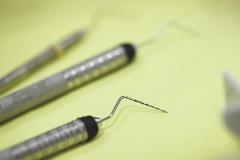Build a Perio Program to Boost Your Production
By Roger P. Levin, DDS
 One of the simplest ways to increase production is to implement a regimented periodontal diagnostic and treatment program. According to Levin Group research, 71 percent of practices don’t probe and record pocket depths even once a year, and over 60 percent of dental patients have some level of gingival or periodontal disease. Given these two factors, building a strong perio program creates an opportunity to improve patient care and increase practice production. Following are strategies for building a periodontal program:
One of the simplest ways to increase production is to implement a regimented periodontal diagnostic and treatment program. According to Levin Group research, 71 percent of practices don’t probe and record pocket depths even once a year, and over 60 percent of dental patients have some level of gingival or periodontal disease. Given these two factors, building a strong perio program creates an opportunity to improve patient care and increase practice production. Following are strategies for building a periodontal program:
- Market the periodontal diagnostic and treatment program to all patients. Educational emails, intentional scripting in patient communication and doctor reinforcement will help patients better understand periodontal disease and view your office as a leading clinical practice.
- Diagnose every patient annually. Begin probing every patient annually and evaluate other diagnostic factors such as tissue color, texture and bleeding. One mistake that I see frequently is that practices treat patients with periodontal issues and still use basic prophy insurance codes. Periodontal codes are very specific and should be used appropriately. Periodontal treatment has higher fees than regular hygiene visits, and the appropriate codes will allow for a higher reimbursement. Also keep in mind that periodontal patients often need more than two visits per year. The additional follow-up will help your patient build a strong hygiene program.
- Gain buy-in from the hygienist. Dental hygienists have tremendous potential to enhance a practice’s diagnosis, treatment and production. However, in most practices, they are highly underutilized (and underestimated), resulting in a deficiency in all three of these areas. To help ensure a successful periodontal program, you must develop an understanding between you and your hygienists regarding the parameters of diagnosis and treatment. Help your hygienists understand your view of diagnosing periodontal disease. While general guidelines are fairly well-established in both dental schools and literature, each doctor has to make a decision about what he or she feels represents a good periodontal disease diagnosis and what does not. During probing, hygienists should aim to indicate the level of periodontal disease and whether or not additional diagnosis is necessary. Of course, there are other factors to be considered, including radiography, to determine what effect the periodontal disease may be having on a specific patient. The doctor should work closely with the hygienist to establish guidelines and then continually learn through different cases and patients as the periodontal practice program progresses.
-
Determine the level of necessary treatment. Many general practices are comfortable providing patients with treatment after they have been diagnosed. However, I recommend that general dentists meet with a periodontist and talk about how they can work together. Ultimately, coordinating with the periodontist will ensure that you both maintain the best interests of the patient.
-
Evaluate the effect that a periodontal program can have on practice production. Your dental practice is both a clinical practice and a business that must make a profit to survive. Calculate the number of active patients, hygiene visits and other relevant factors to determine how periodontal diagnosis will affect practice production. In every case where a periodontal diagnostic program has been established, production will increase if some level of treatment is provided. This is a win-win — the patient wins by receiving proper diagnosis and treatment, and the practice wins by adding additional services.
When you add a comprehensive periodontal program, patients will be impressed with the cutting-edge services of the practice and perceive this as high-level customer service. An increasing number of people are now hearing about the periodontal-systemic link, and they want to make sure that they have excellent oral health so that they have complete overall health. This will make case acceptance easier than ever before.
Even a strong periodontal program could have greater potential. All of the above strategies should be carefully evaluated to determine if this is the right move for your team. A highly successful periodontal program will provide excellent patient care, create an ongoing learning experience for both the doctor and hygienist and increase practice production simultaneously.
Roger P. Levin, DDS, is the founder and CEO of Levin Group Inc. To comment on this article, email impact@agd.org.
